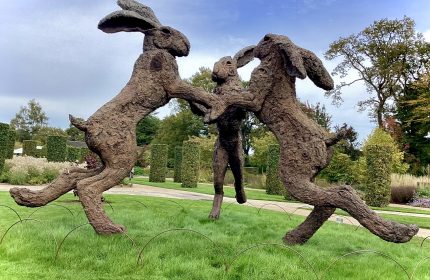How David Attenborough is putting Asia firmly on the wildlife map
Encounter the stars of new BBC blockbuster natural history series Asia by taking one of these tours
It’s the world’s largest continent, with more species than anywhere else on the planet, yet the wildlife and landscapes of Asia are often mistakenly overlooked.
Hoping to correct that imbalance, the BBC’s Natural History Unit spent the last four years collecting dramatic footage for new seven-part series Asia.
Narrated by Sir David Attenborough, the show travels from the frozen north to scorching deserts, visiting the highest mountains, the deepest oceans and the tallest rainforests.
A cast of animal characters new and old will undoubtedly captivate audiences, inspiring nature lovers to head east. Anyone inspired to witness Asia’s wildlife first-hand should check out these trips.
Urban deer
Where: Nara, Japan

Wild deer at the Kasuga Taisha Shrine, Nara Park, Japan
In the world’s most densely populated continent, close contact between people and animals is inevitable. Occasionally, two and four-legged species learn to live harmoniously, as illustrated by the urban deer of Nara in Japan. The sacred animals live in a deer park surrounding the Todai-ji Temple, which houses Japan’s largest bronze Buddha. Gentle and friendly, they frequently approach visitors to nibble on food from their hands. Easily visited as a day trip from Kyoto, Nara is often recommended as a less crowded alternative to the popular city.
How: Families Worldwide offers a nine-night Highlights of Japan family trip, which costs from £3,495 per adult and £3,395 per child, including B&B accommodation, some meals and internal rail travel. Flights extra. Visit familiesworldwide.co.uk
Bengal tigers and one-horned rhinos
Where: Chitwan National Park, Nepal

A Bengal tiger walking on a dirt road in the Chitwan National Park in Nepal
A conservation success story, the number of tigers has more than doubled in Nepal in recent years. As a result of the booming population, the BBC were able to film mating couples less than 100 metres apart. Being one of the few destinations where it’s possible to film the big cats with drones, they captured intimate footage rarely seen.
Anyone hoping to see the Himalayan Kingdom’s resident stars with stripes should head to Chitwan National Park, the country’s first protected area, where one-horned rhinos (who also feature in the series) can be spotted along the Rapti River. October to March is the best time to see both species.
How: Intrepid offers a nine-day Premium Nepal trip from £1,792pp, including B&B accommodation, transport, guides and some meals. Flights extra. Various departures March to May and September to November. Visit intrepidtravel.com
Sun bears
Where: Sepilok and Tabin reserve, Sabah, Borneo

A Bornean sun bear
The final episode in the series highlights different projects working hard to save the wildlife of Asia. One story set to pull at heart strings follows the release of a rescued sun bear back into the wild. A loss of habitat due to deforestation and palm oil cultivation has drastically reduced Borneo’s population of the world’s smallest bear, putting the animals at increasing risk of disappearing. Find out first-hand about efforts being made to stop that happening with a guided tour of the Sepilok Sun Bear Conservation Centre led by Dr Wong.
How: Inside Asia offers a 13-night Best of Borneo tour from £2,795pp, including B&B accommodation and transport. Flights extra. Visit InsideAsiaTours.com
Reef manta rays
Where: Komodo National Park, Indonesia

A reef manta ray at a ‘cleaning station’ in Komodo National Park, Indonesia
Recognisable by their wing-like pectoral fins, the smaller of the world’s two manta ray species can be seen throughout the year in Komodo National Park due to an abundance of food. Since 2014, when the Indonesian government banned the fishing and export of manta rays, populations have increased. But filming them in action isn’t easy. The marine marvels head to areas with strong currents in search of more food and hang in the waves. Less agile humans, meanwhile, are forced to cling to rocks. A much easier spot to observe them is Manta Point, where it’s possible to snorkel.
How: Exodus offers a 13-night Primates & Dragons of Indonesia trip from £3,399pp, including B&B accommodation, some meals and transport. Flights extra. Multiple departures between June and October 2025. Visit exodus.co.uk
Snub-nosed monkeys
Where: Baima Mountain Reserve, Yunnan, China

A young Yunnan snub-nosed monkey
They may not be the most famous animal resident in China, but Yunnan’s charismatic primates are set to capture viewers’ hearts. When the Baima Mountain Reserve was established in 1983, there were only 800 Yunnan snub-nosed monkeys. But thanks to habitat improvement and protection efforts, there are now estimated to be 3,000 of one of the world’s most endangered primates. Tourists can take guided hikes of the reserve on the border with Tibet, best accessed from the town of Benzilan.
How: Trailfinders offers a seven-night Tea Horse Road tour from £2,219pp, including B&B accommodation, transfers and some meals. Flights extra. Visit trailfinders.com
Asia will begin on BBC One on Sunday November 3 with all episodes available as a seven-part box set on BBC iPlayer.
The Press Association
Latest posts by The Press Association (see all)
- In Pictures: Party stalwart kept New Labour in touch with traditional supporters - November 21, 2024
- 6 easy indoor exercises to try this winter – and why they are good for you - November 19, 2024
- Martin Clunes: I can’t afford to retire – I’ve got too many horses - November 19, 2024
- How to avoid plant losses, flowering disappointments and container catastrophes - November 17, 2024
- John Lewis Christmas ad stars sister in last-minute dash back in time - November 14, 2024





















